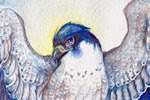My favorite commissions are those involving birds I've never painted before. Not only does it present an opportunity to paint a new subject, but it's also a challenge. I was asked to paint a piebald peacock, which is a peacock with both regular coloration, as well as patches of white plumage.
To start, I did a number of sketches for the client, who said she wanted the wings to be spread. Obviously the tail also needed to be a focal point, which meant the poses needed to be from the back.
Note: For the sake of biological accuracy, I must point out that a peacock's 'tail' feathers are not actually part of the tail at all! They are very, very long feathers that grow from its back. You can see a peacock's true tail, spread in the back while it displays here:
http://www.flickr.com/photos/anulalv/2722509521/Sketches:

The client chose pose #2, with a partially-spread tail and spread wings. I refined the sketch, and did two color sketches:
Finished Sketch: Color Sketches:
Color Sketches:
The client was specific in where she wanted the white - a few patches in the primary feathers, and some of the white feathers with regular 'eyes'. Since the colors were so specific, I only had to do two color sketches to determine where to put the white. As a note - the client requested a 'spontaneous watercolor splash' background, but I used a temporary purplish-pink background simply to show the colors in the color sketch. The final painting will not have that background. #2 was chosen for its symmetry, so I started on the painting.
First Washes:
Since the colors are so tricky in this piece, I put down a very simple wash of the base colors, before starting on any shadow or detail. The tail will be especially challenging because of the nature of peacock feathers - the vane is loose and 'flowy'. To show an example of what I'm talking about, look at this
fanned peacock tail. Note how you have bright green feather over the dark shadow of the feathers behind. With watercolor, you can't paint thin, light details on top of dark shadow, so I would have to paint in each thin strand of shadow in individually. With watercolor, it's important to focus on both the positive and negative space and plan what you will do with highlights and shadows.
Note how the brilliant blues of the eyes look pretty dull. Although I used a very brilliant shade of Turquoise (Holbein), it looks fairly drab when surrounded by such low-contrast yellows. But take a look at the one eye where I put in the detail of dark brown, and you can see how that blue starts to pop.
Tail Detail (Part 1):
Here you can see a bit of the progress from right to left. On the right, I've only started painting in the feather vane with Pthalo Green. The 'sword' feathers are Turquoise. On the left, you can see how I went in with a dark mixture of Van Dyk Brown and Payne's Gray to paint in the shadows. With acrylic, this would have been much easier - I would have painted a layer of dark brown, and then simply gone over the brown with the lighter green. With watercolor, it's very difficult to go dark back to light, so if you want to preserve a brilliant and bright color, you must paint your darks around it.
The feathers at the base of the tail have a wash of Turquoise, gradually blending to washes of Sap Green as they approach the ends. I will be using white acrylic to paint in the feather vane of the white tail feathers, mostly to achieve the brilliant white and fine detail of those feathers.





































